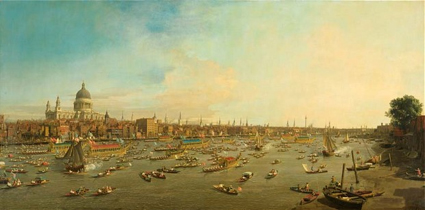“Royal River” at the National Maritime Museum.
“Royal River”, guest-curated by David Starkey, explores the many bends and turns in the historical flow of the Thames. Its subject is the river’s festive and ceremonial relationship to London, and it tells an enthralling if fundamentally melancholy tale. Since its focus is on the ephemeral rituals and displays of the past, this is a show formed throughout from tantalisingly evocative fragments: an illuminated page from a music-book containing a motet composed by the ill-fated Robert Smeaton for the Thames-side festivities that accompanied the coronation of Anne Boleyn; a faded scrap of vellum from the so-called “Anthony Roll”showing a vivid anonymous artist’s impression of Henry VIII’s prize three-master, the Anne Gallante; a vivid etching by Dirck Stoupe revealing the crazed throng of river pageantry, complete with a procession of perilously top-heavy, ornately carved barges, that greeted the entry to London of Charles II’s new queen, Catherine of Braganza, in 1662.
Such images are accompanied by a miscellany of quaint, beautiful or simply curious objects dredged from the deepest bed of the river’s history, ranging from a violin once possibly played on a royal barge in Stuart times, to an engraved souvenir cup purchased at the 1683-4 Frost Fair – a vivid memorial of London’s so-called “mini-Ice Age”, when the Thames frequently froze so solid that London’s boatmen were forced to change profession and turn hawker or peddler, setting up vending stalls and refreshment stands among the vast wave-like forms of the river’s icy surface.
How busy, how buzzing, how vital the Thames once was: not only London’s artery but its main thoroughfare, and its principal arena for public entertainments. When the Elizabethan traveller George Sandys visited the oppressively teeming city of Naples, the best way he could find to convey its sheer populousness...


